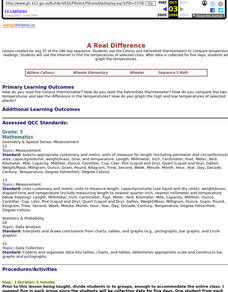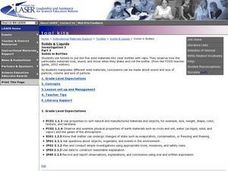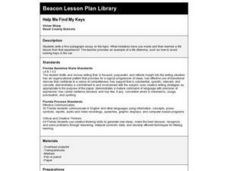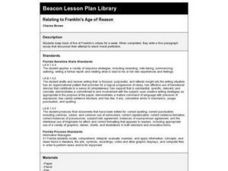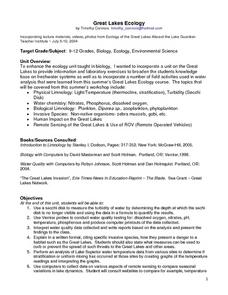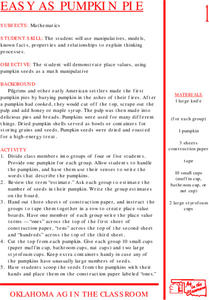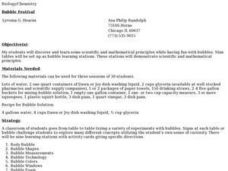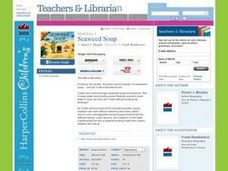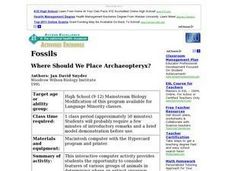Curated OER
A Real Difference
Fifth graders use the Celsius and Fahrenheit thermometers to compare temperature readings. They use the Internet to find the temperatures of selected cities. After data is collected for five days, 5th graders graph the temperatures.
Curated OER
Solids in Bottles
Students use funnels to put the five solid materials into clear bottles with caps. They observe how the particulate materials look, sound, and move when they shake and roll the bottle. Finally, students write "sound and touch" poetry.
Curated OER
Help Me Find My Keys
Fourth graders write a five-paragraph essay on the topic: What mistakes have you made and then learned a life lesson from that experience?
Curated OER
Homes for Hermit Crabs
Learners discover the differences between hermit crabs and mollusks and identify their parts. After reading a story about hermit crabs, they complete an anatomy worksheet. For another activity, students fold and cut a diagram of a hermit...
Curated OER
Living and Nonliving
Students use their senses to record and collect data. In How Do I Classify Things in My World?, students practice classifying objects as living or nonliving. In Is it Real Or Pretend?, students group objects as real or pretend. In What...
Curated OER
Outdoor Observations
Fifth graders attain data using their senses. They record information. They develop observation skills and explore how to investigate. They gain appreciation for nature through their observations.
Curated OER
Relating to Franklin's Age of Reason
Fourth graders read a selection describing 13 virtues from "The Autobiography of Benjamin Franklin." They keep track of their behavior and whether or not they can keep up with 5 chosen virtues. They write a 5 paragraph essay on their...
Curated OER
Gyotaku Lesson Plan
Learners study the Japanese art of fish painting called Gyotaku while examining the lifestyle of Japanese fishermen at the end of the Edo period. They make a Gyotaku fish print and write a haiku poem using the proper number of syllables...
Curated OER
Great Lakes Ecology
Eighth graders identify the Great Lakes, and describe the habitat of life of a loon. They are able to point to and explain one of the major river systems that enters the Great Lakes with a focus on the Clinton River and the food webs...
Curated OER
EASY AS PUMPKIN PIE
Students demonstrate place values using pumpkin seeds as a math manipulative. They use manipulatives, models, known facts, properties and relationships to explain thinking processes. They estimate the number of seeds in their pumpkin.
Curated OER
Bubble Festival
Students practice scientific inquiry while learning about bubbles. In this lesson about bubbles, students explore characteristics of bubbles. Students move through nine different "bubble" stations following directions and completing an...
Curated OER
Iditarod Experience Journal
Learners use online race updates of the Iditarod race and musher information to create a journal that one of the racers might have kept while participating in the race between Anchorage and Nome.
Curated OER
What About Cantaloupes?
Second graders investigate the physical properties of cantaloupe using their senses. In this life science lesson, 2nd graders estimate the weight of their sample. They get it's actual weight and compare it with their estimate.
Curated OER
Art & Drama for Middle Grades
Students define humor and consider how people have different senses of humor and therefore different ideas of what is funny. They explore improvisation, cartooning, comics, body language and storytelling as the means to express humor.
Curated OER
You Won't Believe Your Eyes!
Students gain a basic understanding of the sense of sight. They watch a video on sight, then engage in some vocabulary games, and perform some simple experiments which focus on the basics of sight.
Curated OER
Seaweed Soup
Students read the book Seaweed Soup and learn about matching. For this matching lesson plan, students read the given book, and have to keep track of all the different bowls, cups, spoons, and napkins on the table by matching them up.
Curated OER
Hey, Look Me Over!
Students make observations about mealworms using hand lenses, rulers, and cotton swabs. Students complete their own mealworm observation chart, then they share their observations with the class. This is one station out of five in an...
Curated OER
Using the Correct Vocabulary to Solve Problems
Third graders examine the vocabulary and strategies to be used with addition, subtraction, and multiplication word and story problems. They observe the teacher solve a variety of problems, then write and illustrate their own original...
Curated OER
Vroom, Vroom, Vroom! Off We Go!
Students practice sentences and short books to improve their fluency. They read practice sentences to model fluent reading. They review decoding strategies for unknown words including cross-checking. They read with their partner and...
Curated OER
Air Quality and Transportation
Second graders study about air pollution and the effects it has on our Earth. Students tally cars on a sheet that has been categorized as follows: One person in car, two persons in car, or three or more persons in car. Students go to...
Curated OER
Percents
Sixth graders, while in the computer lab, participate in the game Mission Magnetite where they utilize percents and fractions to stop Hacker from dropping magnetite on Motherboard Central. They follow the instructions precisely as they...
Curated OER
Travel, Photography and ISLA
Learners examine and research habitats, and analyze how to shoot travel photographs. They take five environmental portraits, present them to the class, and critique the students' slides.
Curated OER
Where Should We Place Archaeopteryx?
Learners classify Archaeopteryx using pictures of actual fossils and scientist representations of how the animal might have looked. They compare Archaeopteryx's characteristics to those of the five extant vertebrate groups to...
Curated OER
Managing My Money
Second graders use The Berenstain Bears' to learn about money management. For this money management lesson, 2nd graders read The Berenstain Bears' Dollars and Sense book and complete the 'Rainy Day' worksheet. Students then discuss the...
